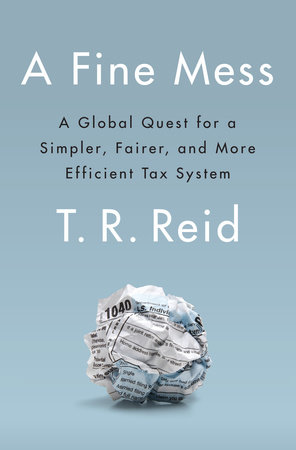A Global Quest for a Simpler, Fairer, and More Efficient Tax System
By T.R. Reid, 2017
T.R. Reid draws on impressive global reporting (as in The Healing of America, 2010) to assure us that there are far better ways to do our taxes, some of them absurdly simple, just common sense. So, what gets in the way?

Politics: every 32 years, the U.S. tax code gets so byzantine that Congress makes a big show of fixing it, then turns around and adds hundreds of tax breaks every year as acts of fealty to wealthy special interests. The favored solution is BBLR = “broad-based, low-rate” taxes, with no deductions or credits. Almost everyone pays so that government can cut tax rates in half, yet still collect the same revenue—maybe even fill out your tax form for you. Whereas the bipartisan tax reform of 1986 was regarded a model of BBLR, Trump’s recent tax bill keeps as many tax breaks (like the notorious “carried interest” break for Wall Street billionaires) as it eliminates, simplifying little.
Yet even an exemplary BBLR system has issues. Economists like it because it is supposed to be “neutral”, leaving business decisions unbiased by taxes. Yet even economists like “sin taxes”, which are biased by design, leaving their reasoning suspect. Also, both the “broad-base” and “low-rate” aspects suggest that the rich will not be paying their share, unless, that is, there are substantial “sin taxes” on excess wealth and income. Reid’s strongest BBLR argument applies to corporate taxes, but, predictably, Trump went for the lower rates without the broad base.
The only particular tax that Reid promotes, is the “VAT”, or value-added tax, now adopted by most countries. Basically, VAT is a sales tax on all goods and services, both wholesale and retail. Tax collectors love it. It is very easy to collect, often hidden in the price, and collects big money, since rates are often 20% or more. To see how it functions, consider a manufacturer who buys raw materials X to make products Y. The manufacturer pays a sales tax on the materials X, and the retail stores pay the same rate on the products Y, but the stores get a credit for the taxes paid on the materials X that went into their products Y. In effect, they are only taxed on the value added by the manufacturer, who’s eager to pass on the discount.
Yet the beloved VAT has the same problem as other broad-based taxes with uniform rates – it is regressive, just like flat-rate income taxes. Reid found that in Eastern Europe, these flat-rate taxes simply did not bring in enough revenue. That is, tax rates that are acceptable to the working class and lower middle class simply don’t cut it, leading to high VAT rates, or property taxes, etc., and eventually a political backlash.
Reid briefly touches on the “no taxes” option, but only in the context of oil-rich or tourist-rich countries. He does not even mention Modern Money Theory, which posits that countries similar to the U.S. could finance a considerable portion of government investment simply by digitally printing money, subject only to an inflation target. Instead, private banks create most money today via loans, mostly for the benefit of affluent Americans.
Yet, all in all, I can recommend Reid’s book as easy and stimulating reading. Though not comprehensive, it will open your mind to concepts of taxation rarely covered by mainstream media.
Find the book here.
